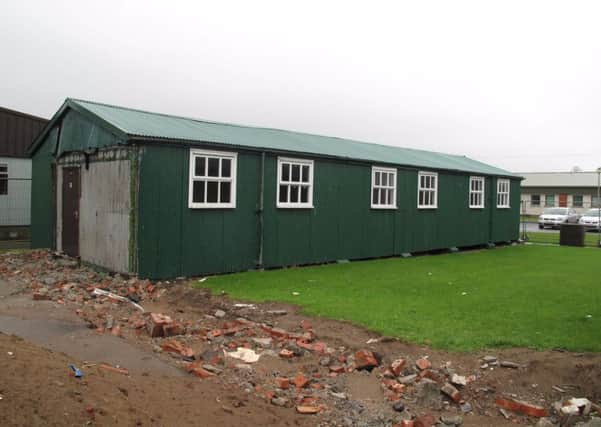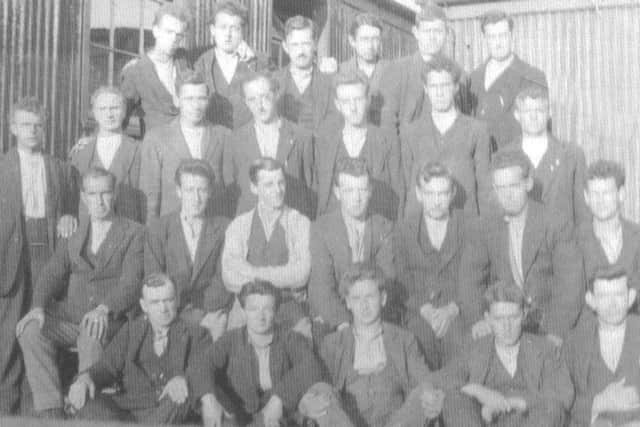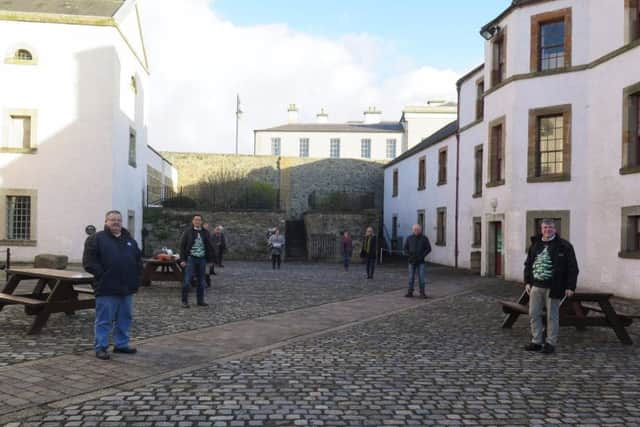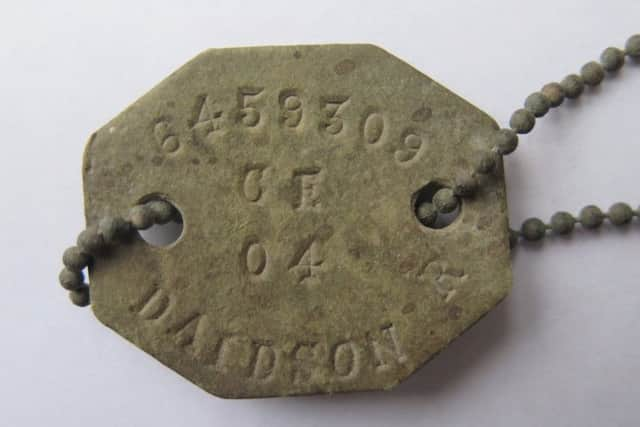How a hut will tell the fascinating story of Ballykinlar Camp


Ballykinlar Camp in Co Down – more recently referred to as Abercorn Barracks – was originally established in 1892 as a British Army training ground, later going on to house internees, soldiers and refugees over the course of the following half a century.
The recently launched, Shared History & Culture project, funded by EU PEACE IV money, aims to bring the stories of the people who stayed in Ballykinlar during this period, back to life.
Advertisement
Hide AdAdvertisement
Hide AdThe end result will be the ‘Ballykinlar History Hut’, an interactive exhibition at Down County Museum which will be housed in the recreated Armstrong Hut, removed from the Ministry of Defence base in 2012.


The project will be delivered by Queen’s University’s Centre for Data Digitisation & Analysis and The Living Legacies 1914-18 Public Engagement Centre in partnership with Down County Museum and Newry, Mourne & Down District Council.
Mike King, the museum’s heritage manager, said: “The stories connected to Ballykinlar are so diverse.
“You had the soldiers who trained there during the First World War and the internees who were there from 1920 to 1921.
Advertisement
Hide AdAdvertisement
Hide Ad“American GIs were also based at Ballykinlar during World War Two in addition to refugees from Malta.


“We’ve also got a story we’re trying to track down of a German prisoner of war who was still there after the war because they couldn’t find him anywhere to go back to.”
He added: “There would have been a very uncertain atmosphere at Ballykinlar. There were different kinds of hardships suffered by the people who stayed there.
“Internees did not know when they’d get home or if they’d get home. Soldiers didn’t know how long it would be until they got home or where the war could take them. Their fates were uncertain.
“Refugees were far from home as were the American GIs.


Advertisement
Hide AdAdvertisement
Hide Ad“If we can recount these peoples’ stories it will make for a really interesting project.”
Dr Heather Montgomery, Living Legacies project officer said: “We want to engage with the community about people who occupied the camp.
“In particular we would like to find out if anyone from Malta stayed in Northern Ireland after living at Ballykinlar.
“We’d also like to try and trace the stories of any women who worked or stayed at the camp in the early 1900s.
Advertisement
Hide AdAdvertisement
Hide Ad“We’re just starting that part of the project, trying to find out more about the residents of Ballykinlar.
“I’ve previously undertaken historical and archaeological research on the First World War training Camps in Ireland, including Ballykinlar Camp.
“I hope to engage again with some of the many experts I’ve already connected with, to generate historic content during this project.
“We have autograph books of internees from all over Ireland, we’ll be trying to trace some of those families.”
Advertisement
Hide AdAdvertisement
Hide AdWhen the people behind the project are able to put more flesh on the bones of these fascinating stories with the help of the public and historical experts, they will use interactive technologies to retell the amazing tales inside a recreated hut, measuring roughly 20 foot by 60 foot, based on an example salvaged from Ballykinlar Camp in 2012.
The 1900’s period timber ‘Armstrong Hut’ will be brought back to life in the central courtyard of Down County Museum – itself a former barracks – and made open to the public by September 2019.
Dr Montgomery said: “The last of the old huts were taken down in 2012. One of them was taken to Somme Heritage Centre and we got another of them.
“Ours has been in storage and will need a lot of restoration.”
Advertisement
Hide AdAdvertisement
Hide AdMr King said: “We’ll have some original elements of the hut that was removed in 2012 incorporated into the rebuild, but in the interest of health and safety and because of the number of visitors anticipated, we’ll have to rebuild most of it.
“Down County Museum has 50,000 visitors every year. It needs to be robust.
“When it is finished and in place it will be like stepping back in time 100 years.”
When the hut was lifted from Ballykinlar Camp one of the items found underneath was a dog tag which the project’s researchers are trying to find.
Advertisement
Hide AdAdvertisement
Hide Ad“The dog tag found underneath the hut is a ‘living’ example of Ballykinlar history,” said Mike.
Dr Montgomery commented: “We’ll be focusing very much on the early part of the 1900s – internment and the First World War – but there are other parts of Ballykinlar’s history that can’t be ignored such as, the establishment of the UDR (Ulster Defence Regiment) at Ballykinlar (in 1970).”
Mr King added: “Ballykinlar is one place in Northern Ireland where you can really tell the story of what happened during the war of independence and both world wars.
“What was seen as a remote place will be the centre of attention.”
Advertisement
Hide AdAdvertisement
Hide AdDue to its world class sporting facilities, Ballykinlar Camp, was also graced with a number of famous visitors from the sporting profession.
Mr King said: “Another interesting story is that the England World Cup team trained at Ballykinlar after they’d won the World Cup in 1966. All the famous players were there.
“The sporting facilities at Ballykinlar are excellent.
“It will become a centre of excellence for GAA players which is interesting because during internment GAA would have been played on a daily basis.
“There were a lot of cultural activities undertaken by both internees and soldiers, in fact we’re aware of a play that both soldiers and internees put on (on separate occasions).”
Advertisement
Hide AdAdvertisement
Hide AdAt the time of World War One the News Letter described Ballykinlar as a “camp situated in the centre of picturesque country, with the mountains of Mourne forming an imposing background.
“On the edge of the camping ground, and within easy walking distance of the tents, is an arm of Dundrum Bay, and here the men will have swimming and bathing drills. Within sight of the camp is the beautifully situated demesne of Tyrella.”
The Ballykinlar History Hut is fundamentally a peace-building project which has been made possible with EU backing.
The project is funded and supported by the European Union’s PEACE IV Building Positive Relations Programme, with the primary purpose of fostering community engagement, bettering social and cultural relations in Northern Ireland and celebrating cultural diversity.
Advertisement
Hide AdAdvertisement
Hide AdIt will also preserve the archaeological heritage and social history of this remarkable building, its public memory and the material culture of the occupants of the hut throughout its many incarnations.
Dr Montgomery said: “It is very much a peace project. We want to get out to lots of different communities and allow them to share their stories. What we want to do is establish a working community within the project.
“We’ll be taking the groups to internment sites in the Republic of Ireland in Dublin and the Curragh and Ballykinlar itself.”
The ‘Ballykinlar History Hut’ project will be launched on September 29 at Down County Museum and opened to the public in the autumn of 2019.
Advertisement
Hide AdAdvertisement
Hide AdThe project is supported by the European Union’s PEACE IV Programme, managed by the Special EU Programmes Body (SEUPB). Primary objectives of the project are: The promotion of positive relations characterised by respect, where cultural diversity is celebrated, and people can live, learn and socialise together, free from prejudice, hate and intolerance.
The project will pay particular attention to minority groups and those who traditionally have been marginalised in society, so that opportunities will be created that allow for a greater degree of participation and integration within modern society.
It is hoped that strong local partnerships will be forged, an outcome already greatly supported through previous EU PEACE money programmes.
One of the key partners – Down County Museum – is located within a Georgian listed gaol dating to 1796-1830, which was used as a barracks from 1838-1945, and was restored to become a Museum between 1981-1990.
Advertisement
Hide AdAdvertisement
Hide AdAnother key player – The Centre for Data Digitisation and Analysis (CDDA) – is based in the School of Natural and Built Environments, Queen’s University, Belfast, and is amongst the leading Digital Humanities groups in both the UK and Ireland.
Founded in 1999 the centre has consistently pioneered links between information technology and humanities research.